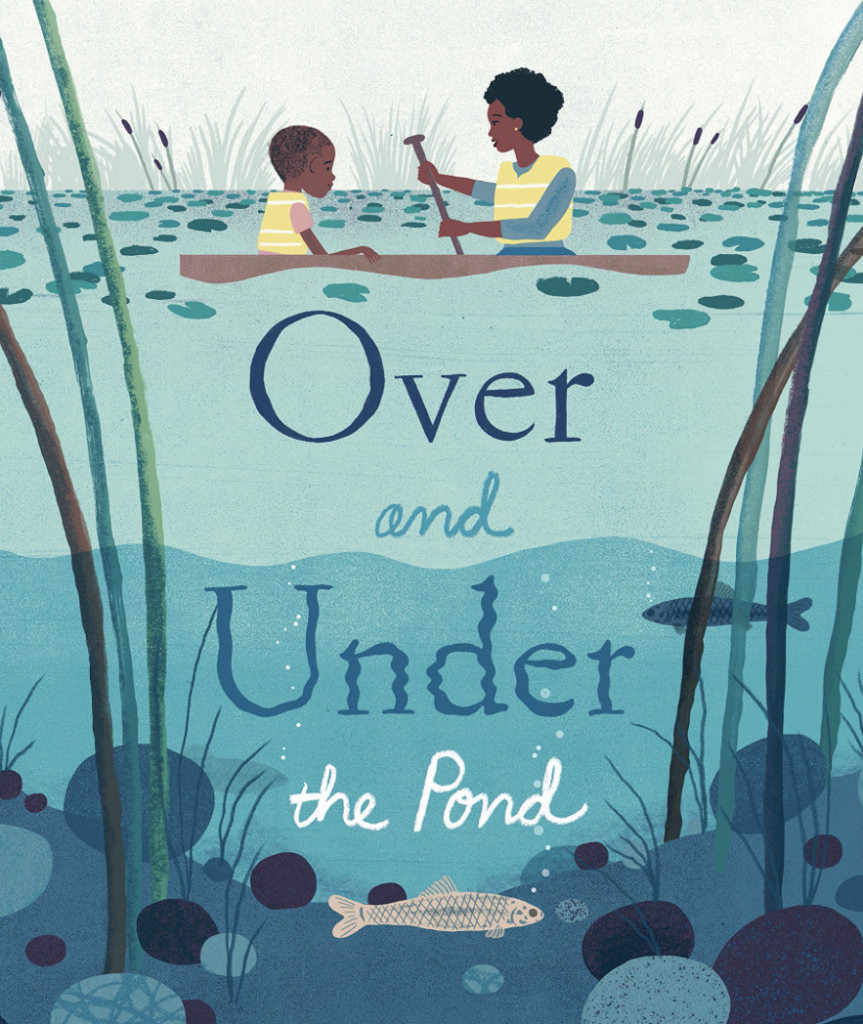
Review by Hailey Swett, book by Kate Messner with art by Christopher Silas Neal
Ponds: what lovely and lively ecosystems! What child doesn’t love exploring a pond, searching for critters big and small? In her picture book Over and Under the Pond, Kate Messner takes young readers on a journey of exploration through a pond, all from the comfort of their homes. In the story, a young child and mother explore a pond together and converse about their discoveries—both in plain sight and hidden far below. The book opens with the child’s natural curiosity:
“What’s down there?” I ask.
“Under the pond?” Mom says.
Thus begins the adventure. The mother starts explaining to the child about all the animals above and below the water level using vivid descriptions and playful language.
Over the pond, we lift and dip and pull past a row of painted turtles on a waterlogged tree. One—two—three— they slip off and away— splash—gurgle—sploosh!—under the pond.
The duo observes bullfrogs, birds, larva, beetles, and minnows. The author anthropomorphizes some of the animals, relating them to activities the child does every day. When a moose looks up with a mouthful of water lilies, the pair notices they’ve interrupted his lunch.
Not only does the child observe the wildlife, they also experience what it feels like to be in nature and watch natural forces at work. Over the pond, they feel the wind giving a push and notice the light-dappled leaves stirring on the shore.
The child witnesses change—such an essential part of the natural world. They learn about the rhythm of life, the progression of time, and the ever-changing quality of nature.
Under the pond, tadpoles are changing, learning to hop. They’re losing tails, growing legs, growing up.
Just as the child is growing and changing, so too are the tadpoles.
The child feels the suspense of a great blue heron wading into water and catching a minnow. Messner’s language creates a sense of wonder. The perspective of the illustrations changes as the child and mother look upwards at a woodpecker far above, searching for ants in a tree.
As a sleepy dragonfly lands for a rest, his spindly legs tickle the child’s leg. The child experiences an interaction with another living being, bringing them even closer to the natural world.
Night comes, and the mother and child paddle back home. They watch the world slip into darkness and hear the animals settling down.
… a far-off loon calls good night. The sky turns from sunset to dusk to dark. Night settles over the pond—the prowling catfish and drowsy turtles, the scuttling crayfish and tadpoles-turned-frogs. Waiting herons and stalking racoons. And the hidden world under the pond.
Following the conclusion of the story, the author includes a note in which she explains the meaning of ecosystem: “an interconnected community of organisms that interact with one another and with their environment.” She points to the interactions of the ecosystem at play in the story, from animals making nests to those searching for food. Additionally, Messner acknowledges that sometimes ecosystems become threatened, a subtle call to action for the children reading the book. In doing so, she plants the seed of stewardship in their minds and brings to the forefront our responsibility for protecting the natural world.
For the particularly curious and intellectual child, there follows an “About the Animals” section in which the author provides descriptions about the almost twenty animals and insects featured in the book, from whirligig beetles to moose and catfish to the great blue heron.
The words and illustrations throughout the book complement each other beautifully, resulting in a magical and wonder-inducing experience for the young reader. Messner—a former teacher—is a seasoned picture book author with at least three other books in print. Her words are accessible and playful. She, herself, lives on a lake and draws upon her experiences in the natural world to create these pieces of literature. The illustrator, Christopher Silas Neal, creates whimsical, simple art that draws in the reader to look more closely. From water bubbles to lily pads and giant moose to tiny minnows, the illustrations capture the reader’s attention.
With their vivid and boundless imaginations, children are naturally drawn to stories, making books a relatively easy method for promoting earth stewardship. There are thousands of wonderful picture books that encourage caring for our natural world. A combination of a carefully written narrative and beautiful, detailed illustrations can result in a potentially magical experience for a child. No matter where they are in the world, they can encounter a polar bear in the Arctic, a poisonous frog in the Amazon Rainforest, or a lion on the plains of Africa.
Books transport; they expand a child’s imagination beyond what lies in their backyard. Over and Under the Pond is a perfect example of this. A child who reads this book is immediately taken to a place—perhaps unlike anywhere they’ve ever been before—where they can learn important lessons about wonder, ecosystems, and stewardship. For any adults looking to foster such attributes in young children in their lives, this book is a wonderful start.
Watch: Over and Under the Pond read aloud:

